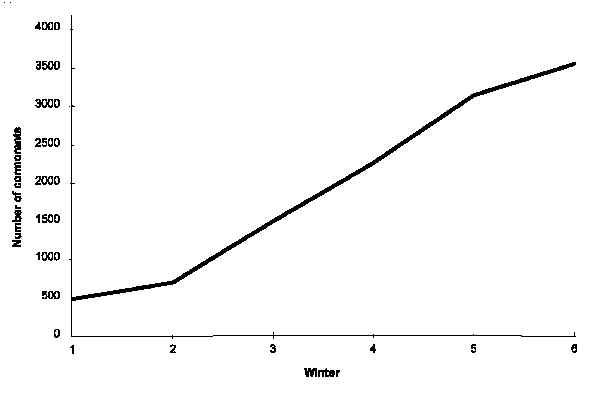 |
| WI - Cormorant Research Group | The Bulletin - No. 3, December 1998 | Original papers | |
RECENT DEVELOPMENT OF THE WINTERING POPULATION OF GREAT CORMORANTS Phalacrocorax carbo IN NORTHERN SPAIN
Jesús María Lekuona & Francisco Campos
Departamento de Zoología y Ecología, Facultad de Ciencias, Universidad de Navarra, c/ Irunlarrea s/n, 31080 Pamplona, Navarra, Spain
Until recently, the northern Spanish regions Navarra and Guipúzcoa were an area where Great Cormorants Phalacrocorax carbo only spent short stays during migration and just a few winter roosts were found. In this note we describe some of the changes in the growth of the wintering population which suggest that in this region carrying capacity has not yet been reached. The development of the wintering population in northern Spain has been described before by Campos & Lekuona (1994), Lekuona & Campos (1995) and Lekuona (1997).
Fortnightly censuses have been carried out each month from October to April at 17 roosts (14 of which belonged to sinensis birds, two to carbo and one, at Txingudi, is a mixed carbo-sinensis roost). The numbers of birds at the roosts were recorded in the evenings. Three age classes were distinguished: young (first winter) birds, immature (second winter) birds and adults. Birds were identified according to their plumage characteristics (Cramp & Simmons 1977, Van Eerden & Munsterman 1995). Fifteen roosts were located in rivers (Urumea and Oria in Guipúzcoa and Ebro, Aragón and Irati in Navarra), three roosts were in coastal habitats and one in a reservoir (Yesa) (Fig. 1). In rivers all selected sinensis roosts were located in trees like poplars (Populus alba and P. nigra), willows (Salix alba and S. atrocinerea) and Ash Fraxinus excelsior. It is obvious that birds of race sinensis are tree-winterers. The Ebro is the largest river in northern Spain and it supports a wide range of fish species, the most important being French Nase Chondrostoma toxostoma, Barbel Barbus graellsii, Gudgeon Gobio gobio, Carp Cyprinus carpio and Goldfish Carassius auratus.
 |
From 1991 until 1997 (Fig. 2) the wintering population of Great Cormorants increased from 485 to 3,548 birds, while the number of roosts censused grew from 9 to 14. The rate of increase ranged from 43.7% to 13% per year (average 52.3%).
 |
From October to March, the proportion of adult birds was high (65-70% of total number of aged birds), but in the second half of March and in April this fraction decreased markedly. In April young birds dominated the age structure, making up 42-54% of all aged cormorants. Mean distance between roost and feeding site was 14 km and a positive correlation was found between roost size and the available surface area of feeding habitat (Pearson correlation, r = 0.5102, p < 0.01, n = 26).
Lekuona (1997) has found that human disturbance was responsible for shifts in winter roost locations. Thus, three roosts disappeared over the years (Azagra, Granjafría and Las Cañas) and three new settlements in river areas were found in Navarra (Irati) and Guipúzcoa (Urumea and Oria). These new roosts were all established by sinensis birds.
In our study area, wintering Great Cormorants came from breeding populations from Denmark, The Netherlands and France (Campos & Lekuona 1994, Lekuona 1997). The wintering population of Great Cormorants in Navarra and Guipúzcoa will continue to increase, but the saturation of several roosts suggests that the expansion in our study area will depend on the ability of the birds to colonise new winter areas.
References
Campos F. & Lekuona J.M. 1994. La población invernante de Cormorán Grande (Phalacrocorax carbo) en el norte de España y suroeste de Francia. Ardeola 41: 13-18.
Cramp S. & Simmons K.E.L. 1977. The birds of the western palearctic. Vol. 1. Oxford University Press, Oxford, London, New York.
Lekuona J.M. & Campos F. 1995. Censo invernal de aves ictiófagas: Cormorán Grande (Phalacrocorax carbo), Garza Real (Ardea cinerea) y Gaviota Reidora (Larus ridibundus) en la piscifactoría de Yesa (1994-95). Anuario Ornitológico de Navarra 1993-94: 17-26. Gorosti.
Lekuona J.M. 1997. Importancia de las aves ictiófagas: Cormorán Grande (Phalacrocorax carbo) y Garza Real (Ardea cinerea) en el norte de España y suroeste de Francia.Ph. D. Thesis, University of Navarra.
Van Eerden M.R. & Munsterman M.J. 1995. Sex and age dependent distribution in wintering Cormorants Phalacrocorax carbo sinensis in western Europe. Ardea 83: 285-297.
J.M. Lekuona & F. Campos, Departamento de Zoología y Ecología, Facultad de Ciencias, Universidad de Navarra, c/ Irunlarrea s/n, 31080 Pamplona, Navarra, Spain